Why is my poha sticky? soggy? mushy? or dry? If you too have struggled to achieve the perfect poha texture, then you have come to the right place! Try my fail-proof Kanda poha recipe, a traditional Indian breakfast dish made with flattened rice flakes, onions and peanuts. This poha recipe will help you achieve the perfect texture you always wanted, whether you're a seasoned cook or a beginner.
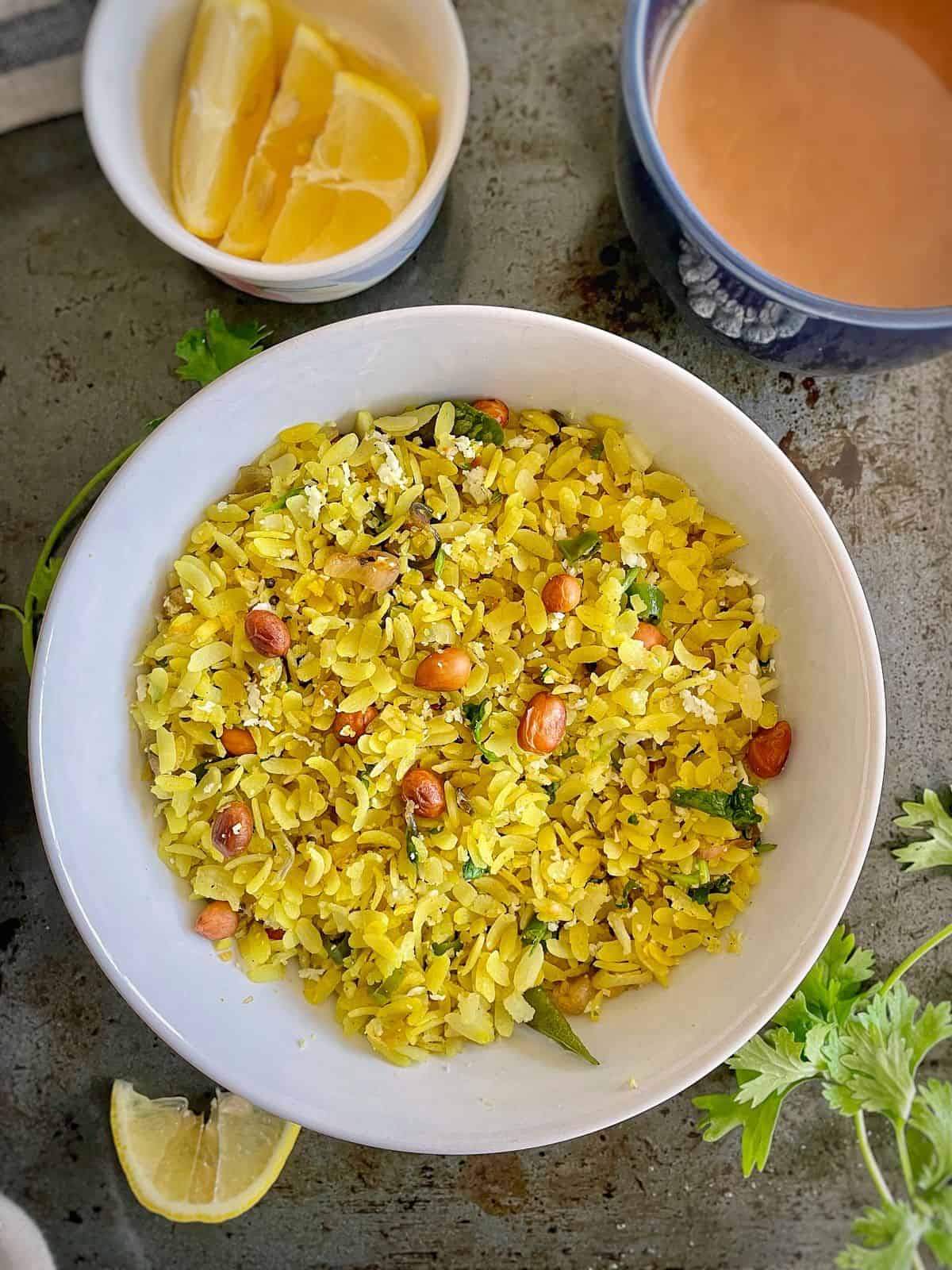
Poha not only refers to beaten or flattened rice flakes but also to the humble Indian savoury breakfast dish served across North and Western states like Maharashtra.
I had my first introduction to Kanda Poha while working in Bangalore. Though almost all breakfast outlets serve it, I loved my colleague's dubba of poha with lots of peanuts.
As a south-Indian, we use Poha aka Aval for sweet dishes like Aval milk or aval kuzhachathu, aval payasam, etc. We also use poha as a substitute for cooked rice in making idli batter or ari dosha. But a savoury breakfast recipe that comes together with hardly any effort? count me in!
Jump to:
What is Kanda Poha?
Kanda Poha, a Maharashtrian-style gluten-free rice-based breakfast dish. The word "Kanda" in Marathi refers to onions, which are one of the key ingredients in this dish. Poha, or flattened rice flakes is the primary component of a Poha recipe. We often enjoy eating Kanda poha with a hot cup of tea or coffee.
Ingredients
Poha is a versatile dish, with variations that can vary from region to region and even from household to household, depending on personal preferences and regional culinary traditions. Here, I am sharing the recipe for Kanda Poha, which represents a classic version of poha prepared with onions (kanda) and spices.

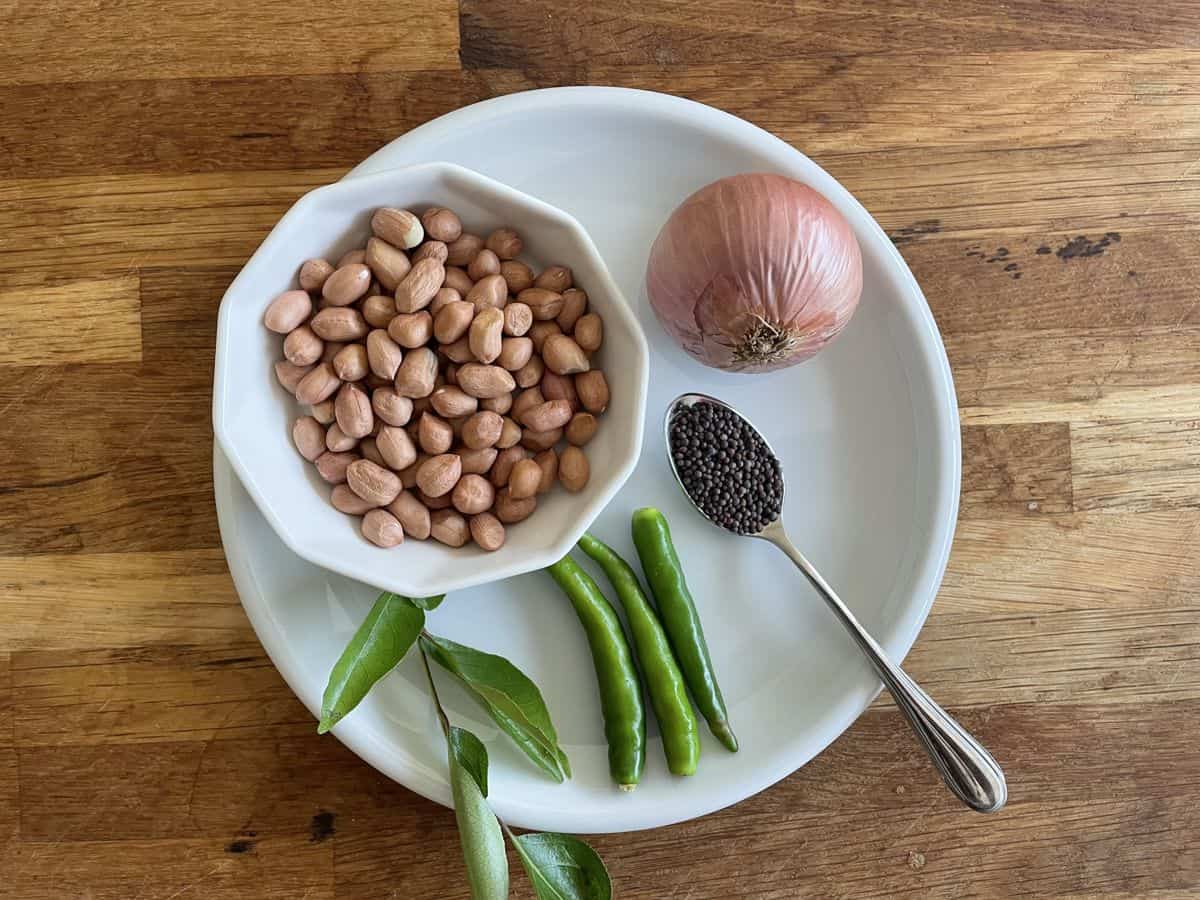
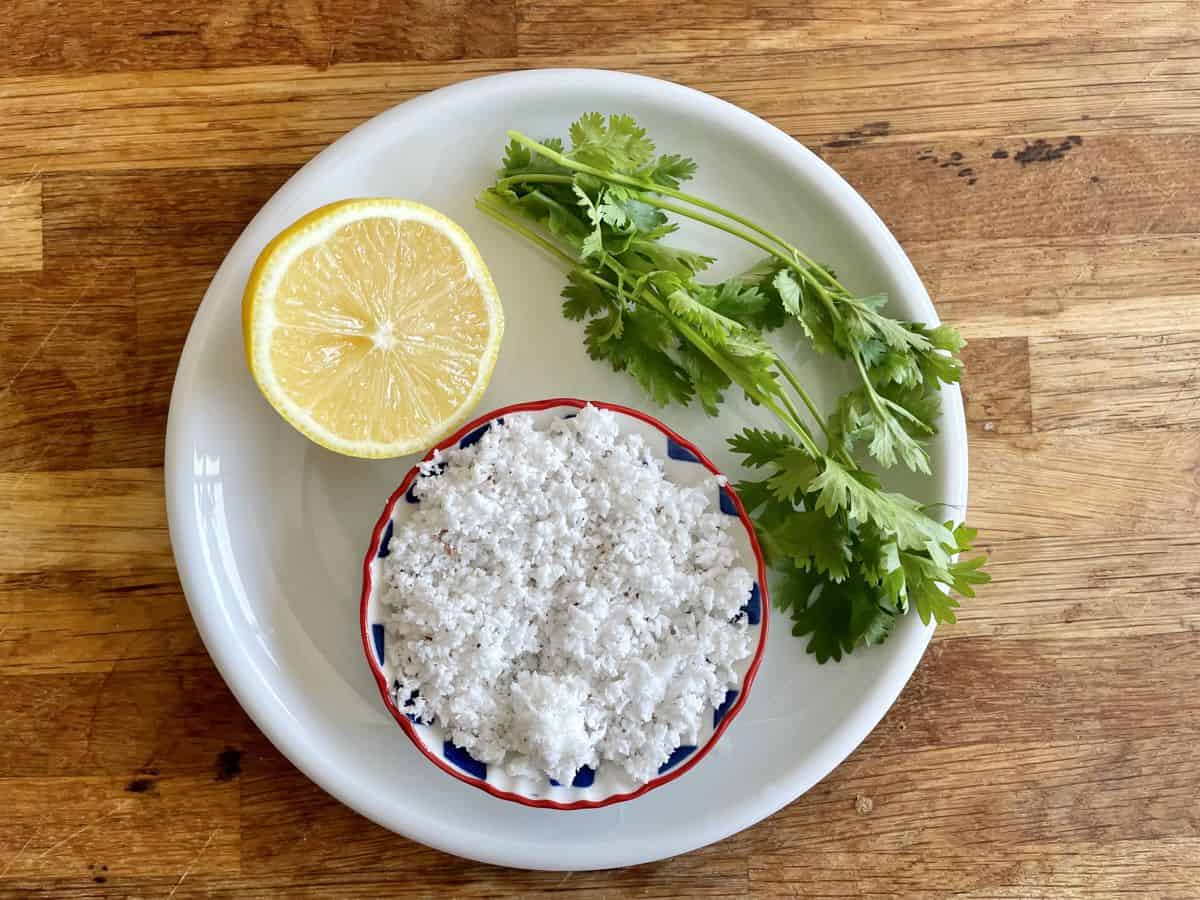
- poha: Currently, there are various types of rice flakes available in the market. You will find red poha made with matta or red rice. White poha made with regular white rice. You will also find them both as thin poha or thick poha. For this recipe, you can use red or white but make sure to use the thick poha.
- water: normal room temperature water
- oil: I always use coconut oil but you can use any cooking oil.
- peanuts: I like to use raw peanuts with skin. You can use other kinds of peanuts like roasted peanuts but the cooking process will change accordingly. Check the recipe card for details.
- mustard seeds
- curry leaves
- red onions
- green chillies
- turmeric powder
- salt
- lime or lemon juice and wedges
- coriander leaves - optional
- grated coconut - optional
See the recipe card for quantities.
Instructions
This Kanda Poha recipe is a popular breakfast and snack dish believed to have originated in the state of Maharashtra, India. Over time, the dish gained popularity due to its simplicity and is now a well-known and loved dish across the country. The combination of softened poha with sautéed onions, peanuts, and other ingredients creates a satiating dish. So, how do you make Kanda Poha? Let's go!
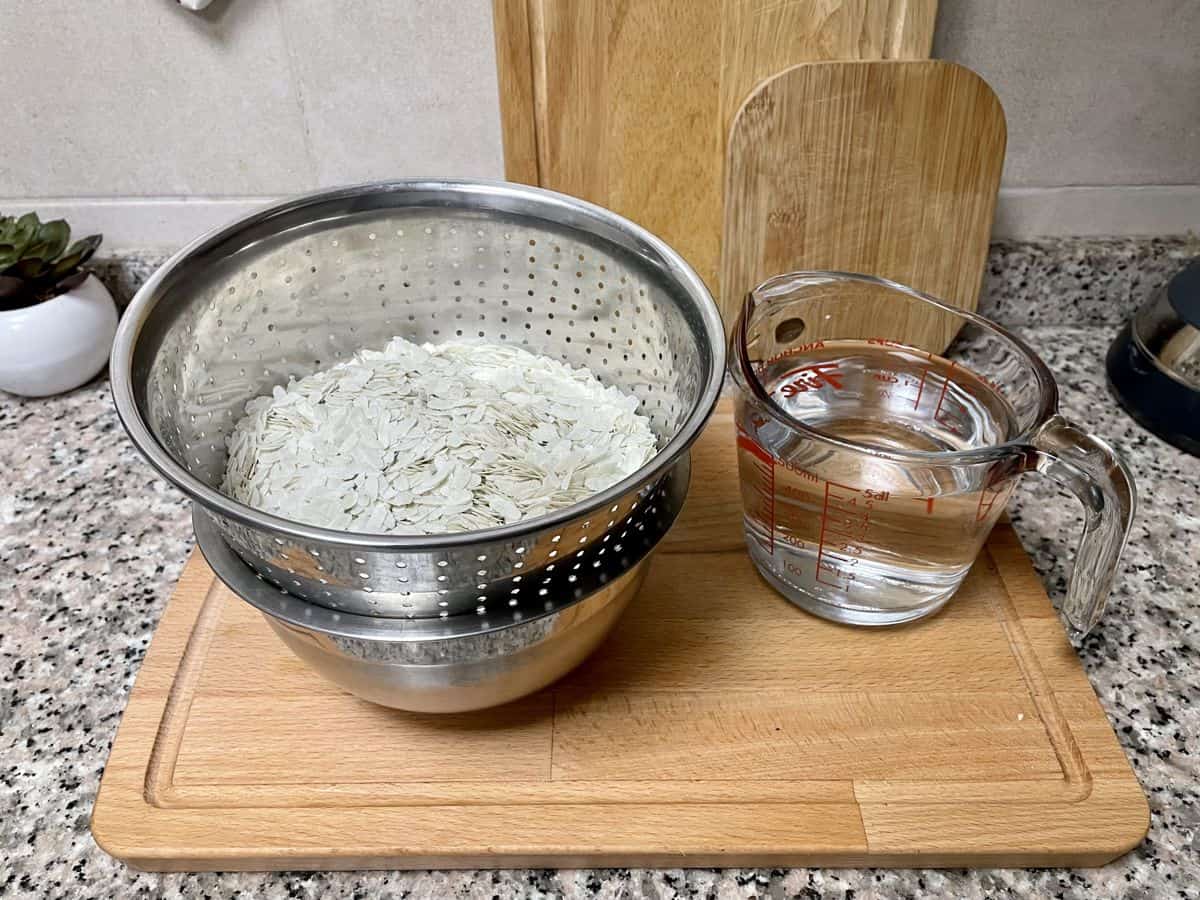
Place the measured-out poha (rice flakes) in a colander with a bowl underneath. Measure the drinking water in a pourable container. This way, you have control over the pour. Might sound silly, but this is the step where your poha can get soggy or too dry.
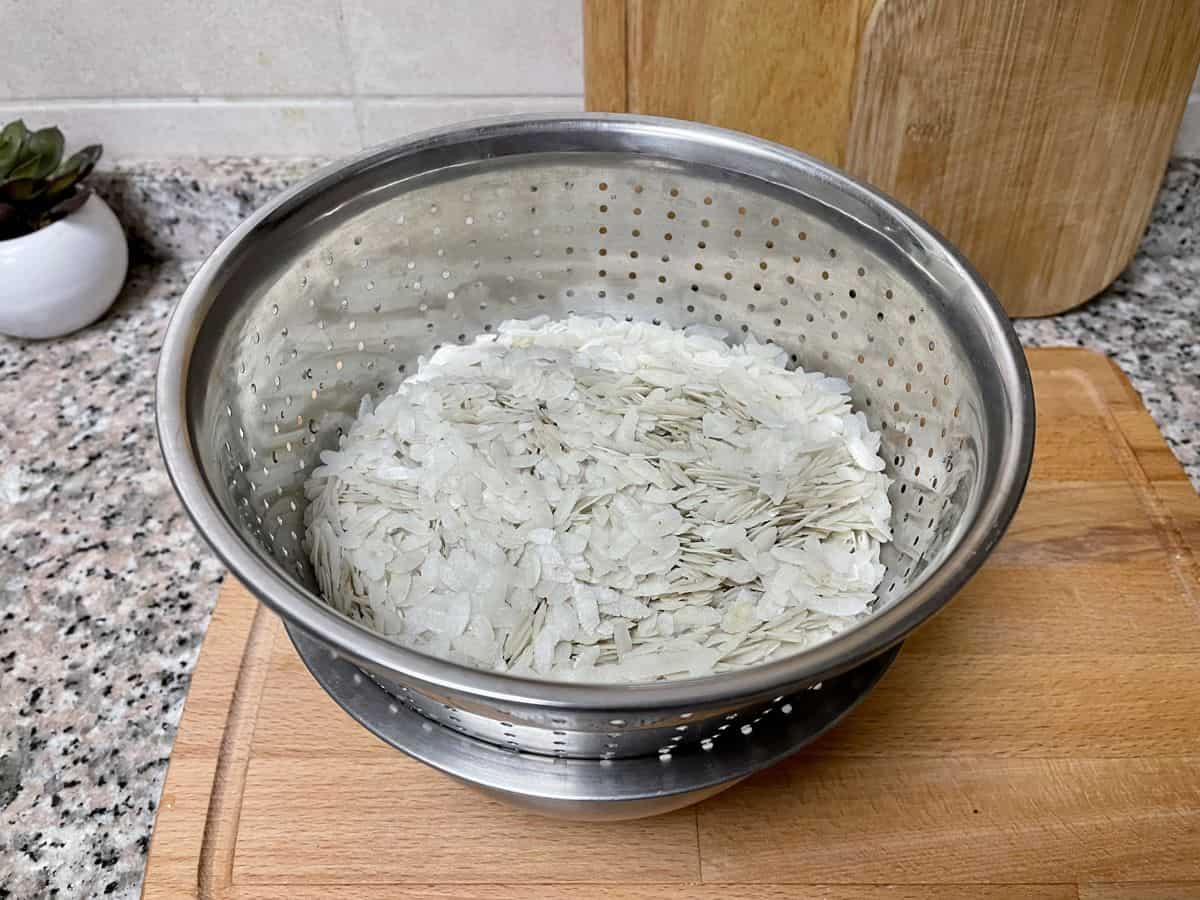
Pour the water carefully all around the poha making sure the surface area is wet. Do not be tempted to stir or flip. Set it aside for about 15 to 20 minutes. You can keep it covered until then for safety.
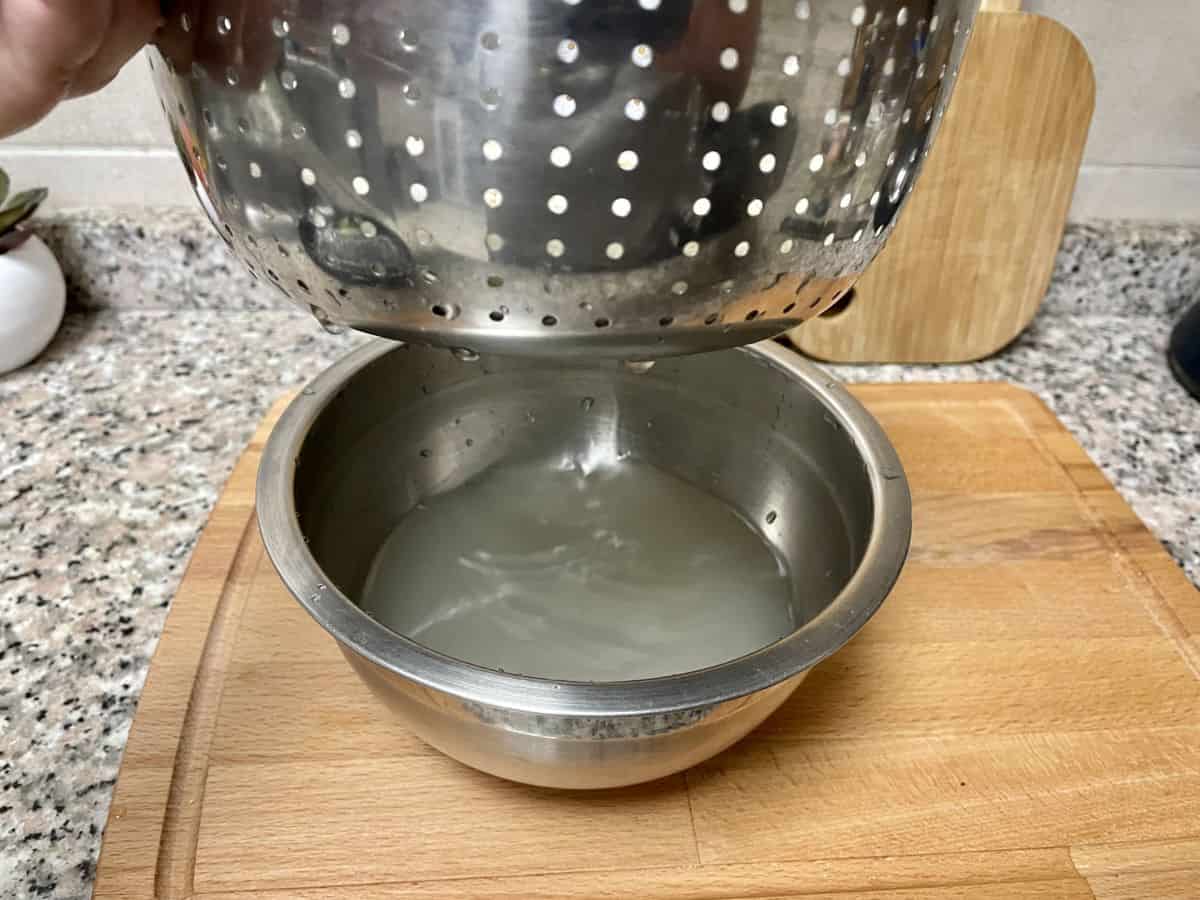
During this time, the excess water will drain off and the soaking time will soften the poha.
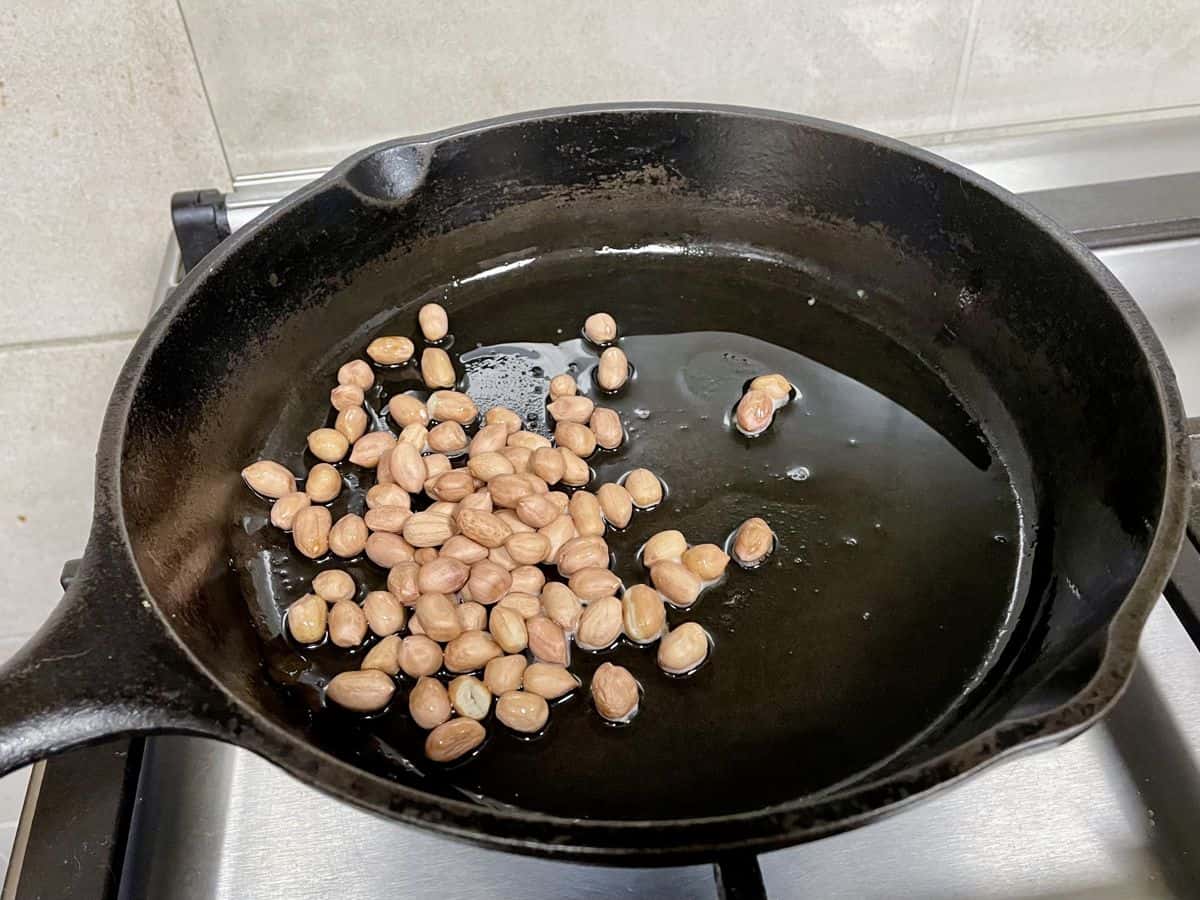
Heat coconut oil in a pan or kadhai over low to medium heat. Add the raw peanuts (with skin) and fry by sauteing until you hear them pop and crack. Make sure you don't burn them.
sauteing
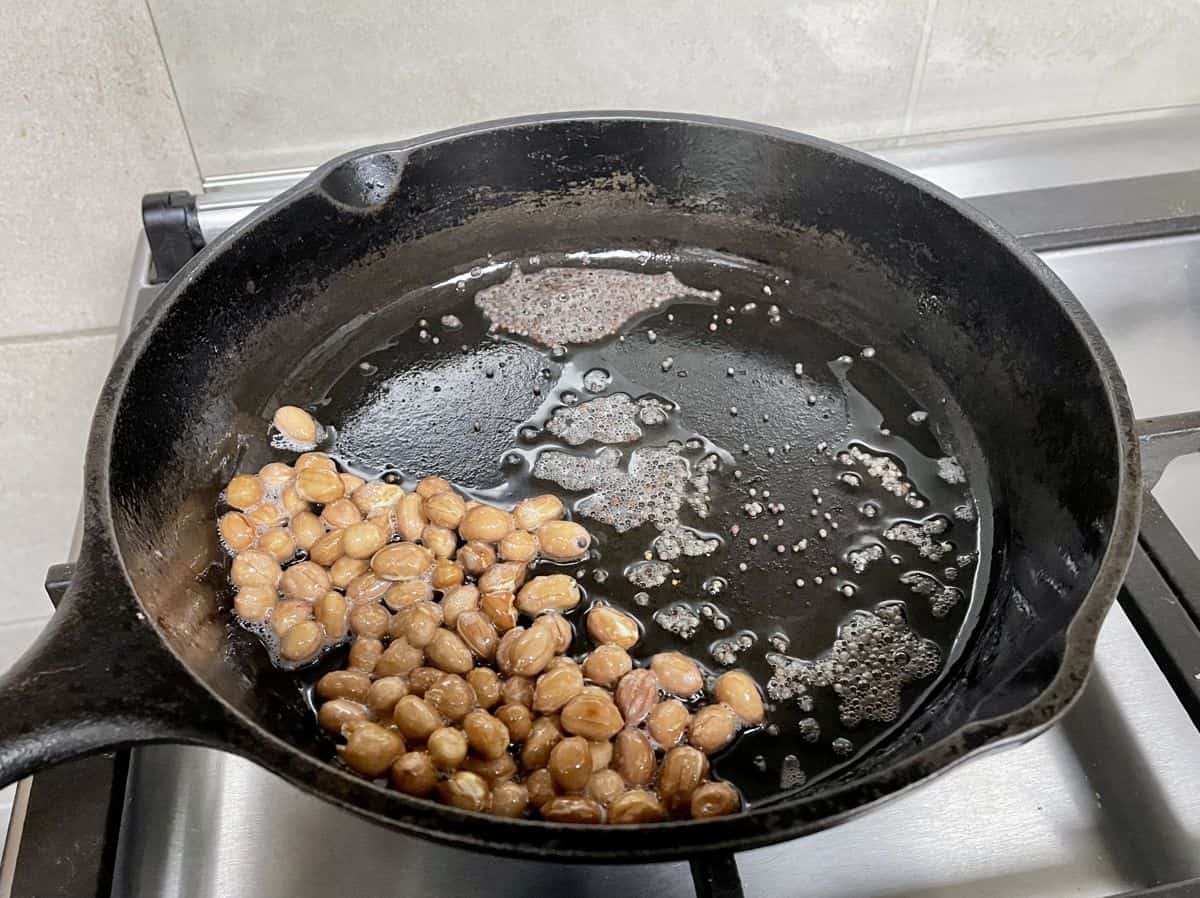
Move the fried peanuts aside and add mustard seeds. Allow them to crackle before the next step.
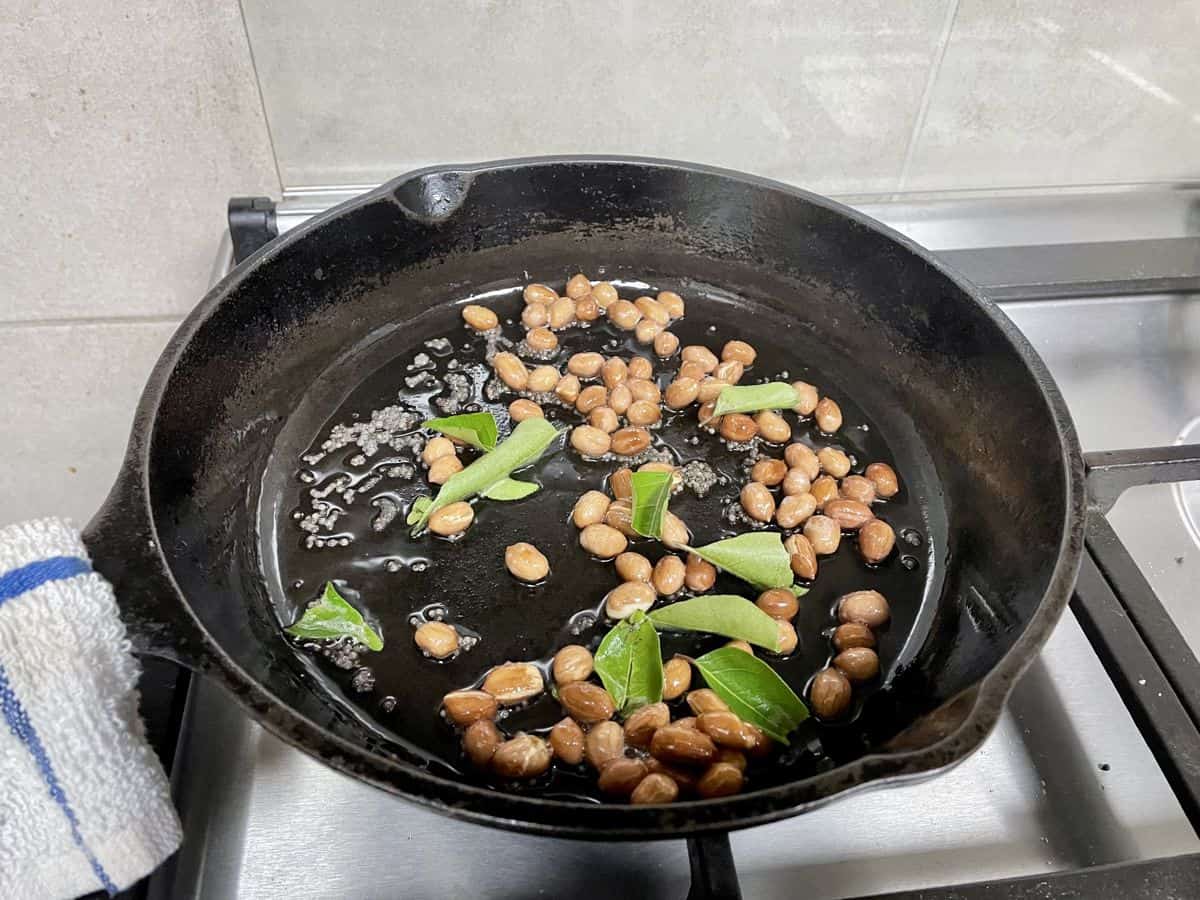
Now, add curry leaves. You may add them whole, torn or chopped finely.
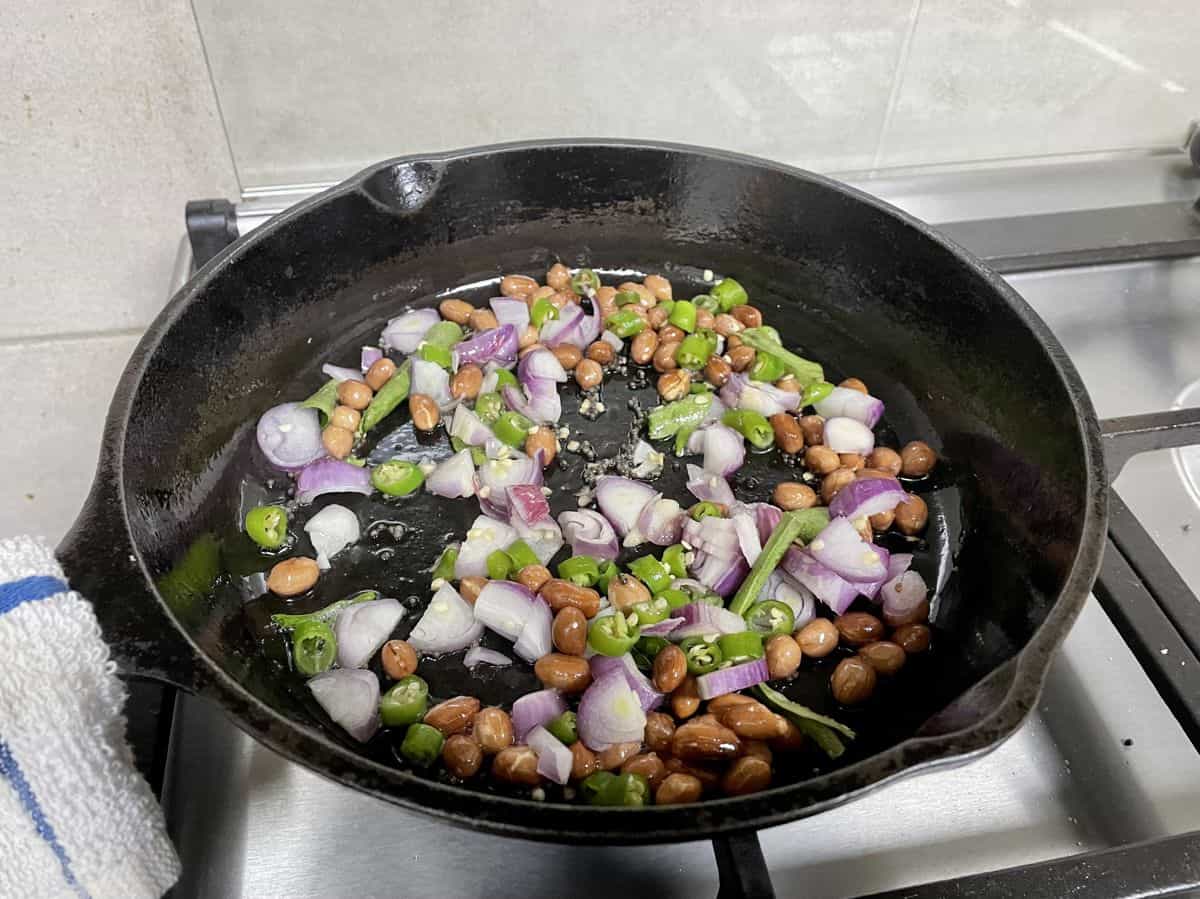
Add the chopped green chillies and diced red onions to the pan. Sauté for a few seconds until they release their aroma.
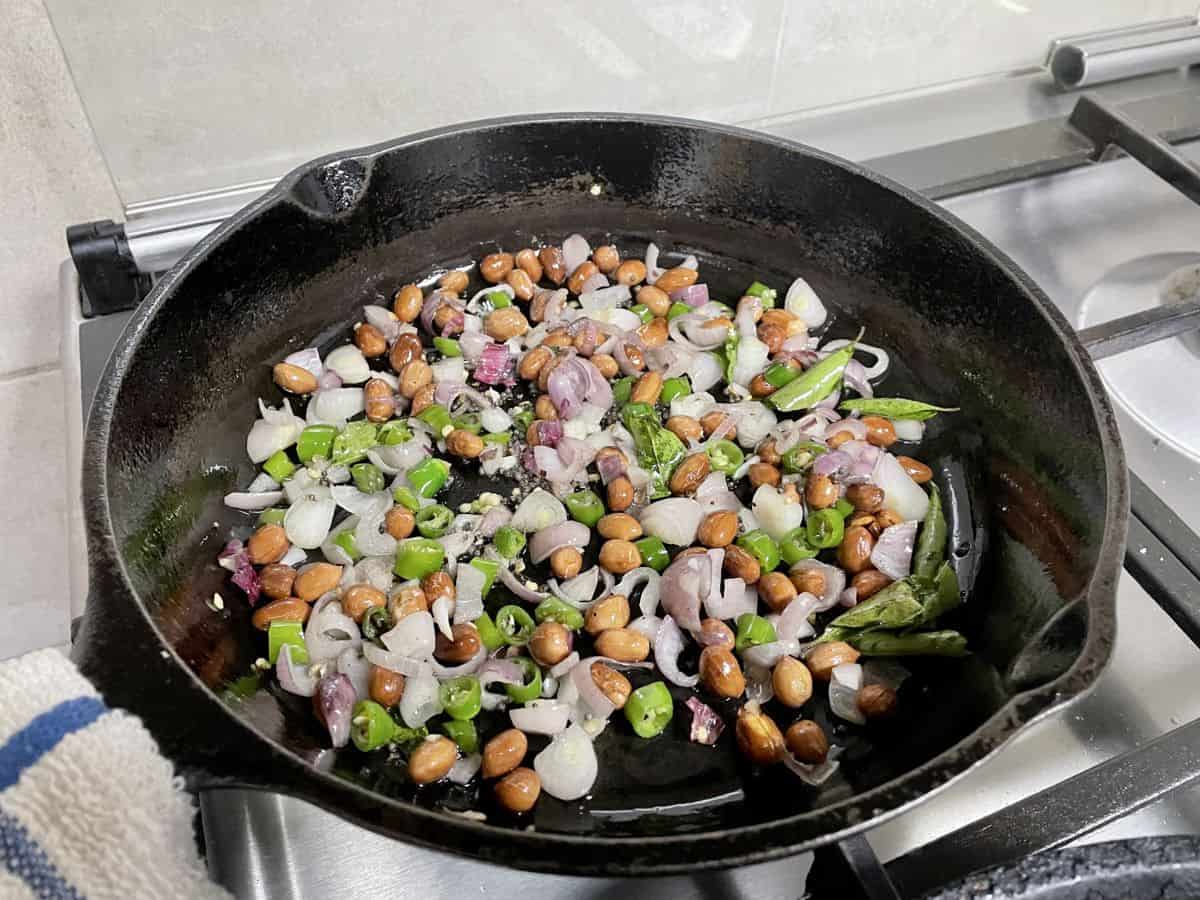
Cook the onions until they turn translucent and slightly golden brown.
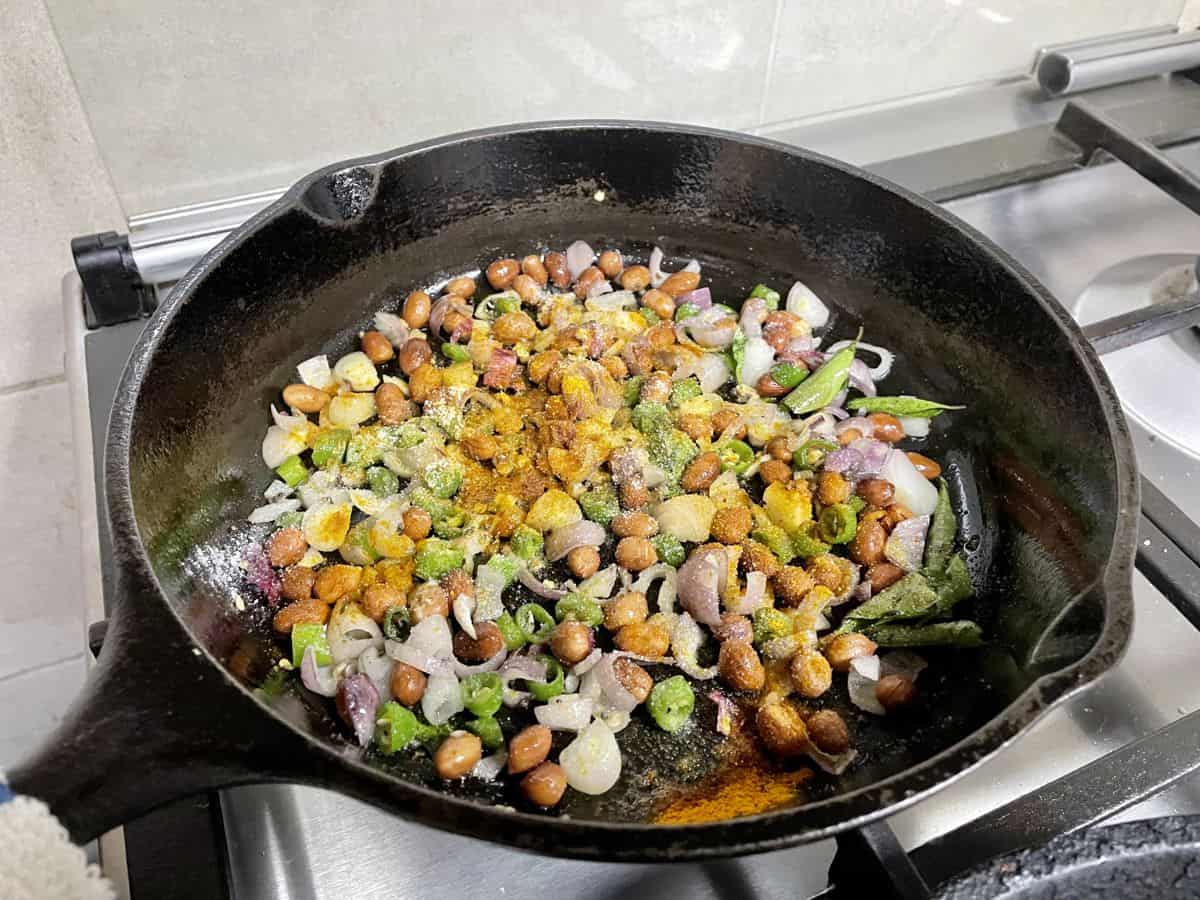
Add turmeric powder and salt to the pan. Mix well, ensuring the spices coat the onions evenly.
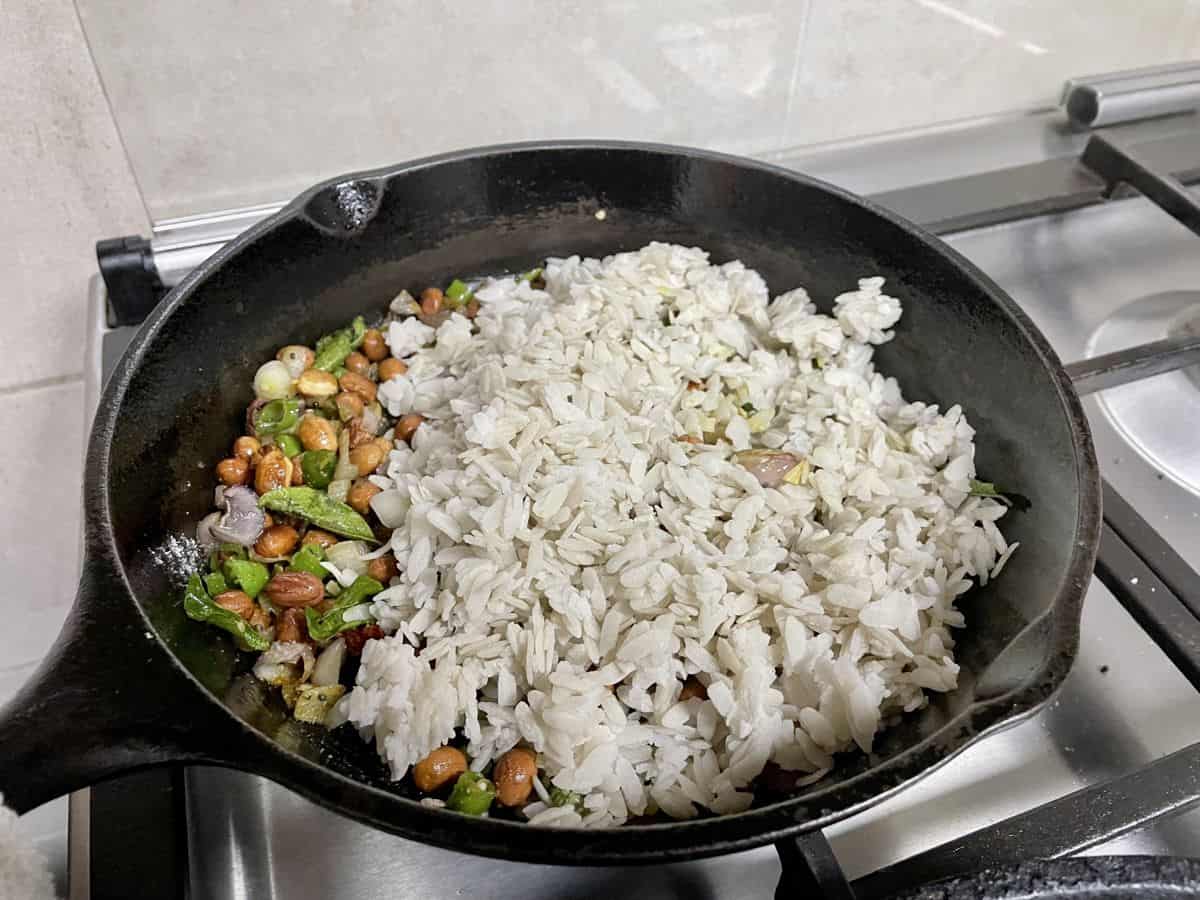
Now, add the soaked and drained rice flakes (poha) to the pan.
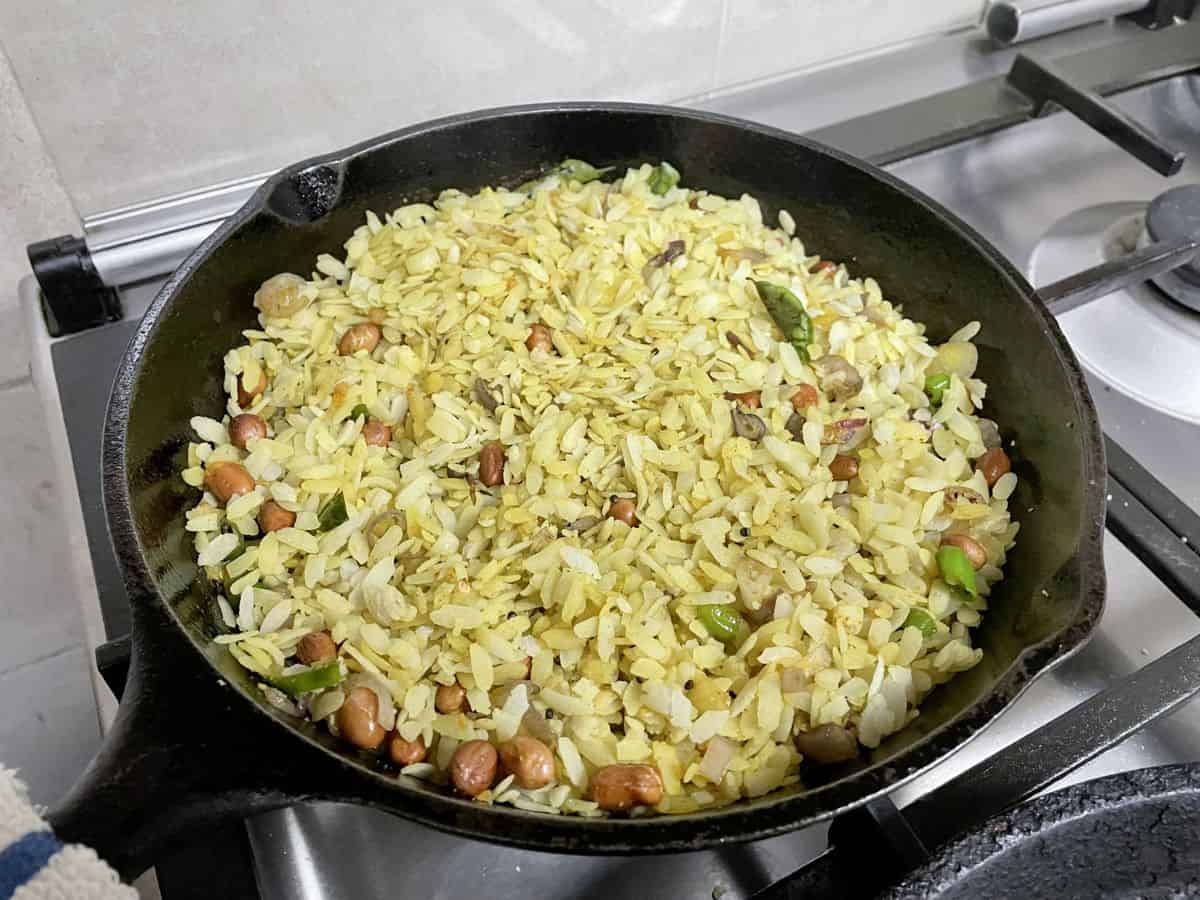
Gently mix everything, making sure the poha is well-coated with the onion and spice mixture.
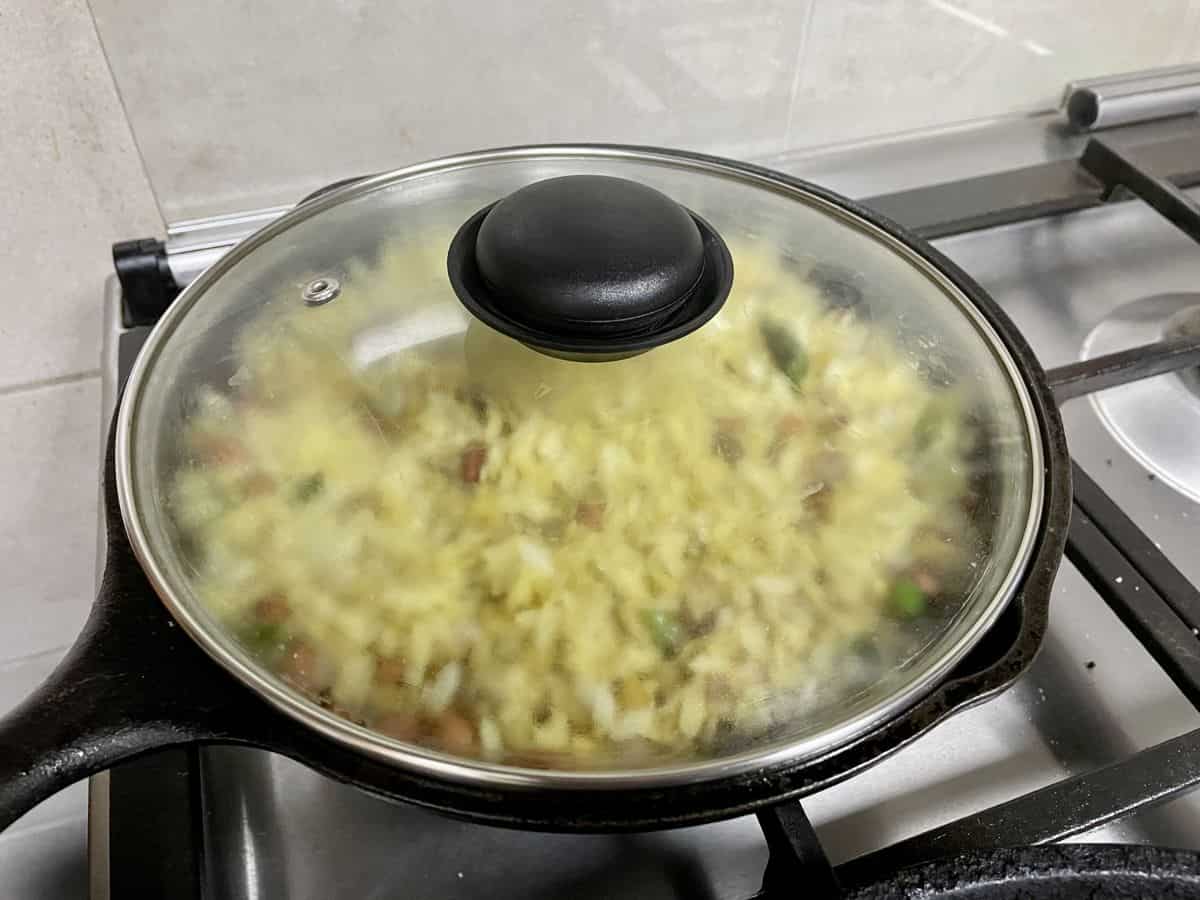
Cover with a lid and cook for about 2-3 minutes on low heat.

Turn off the heat and garnish with grated coconut and freshly chopped coriander leaves.
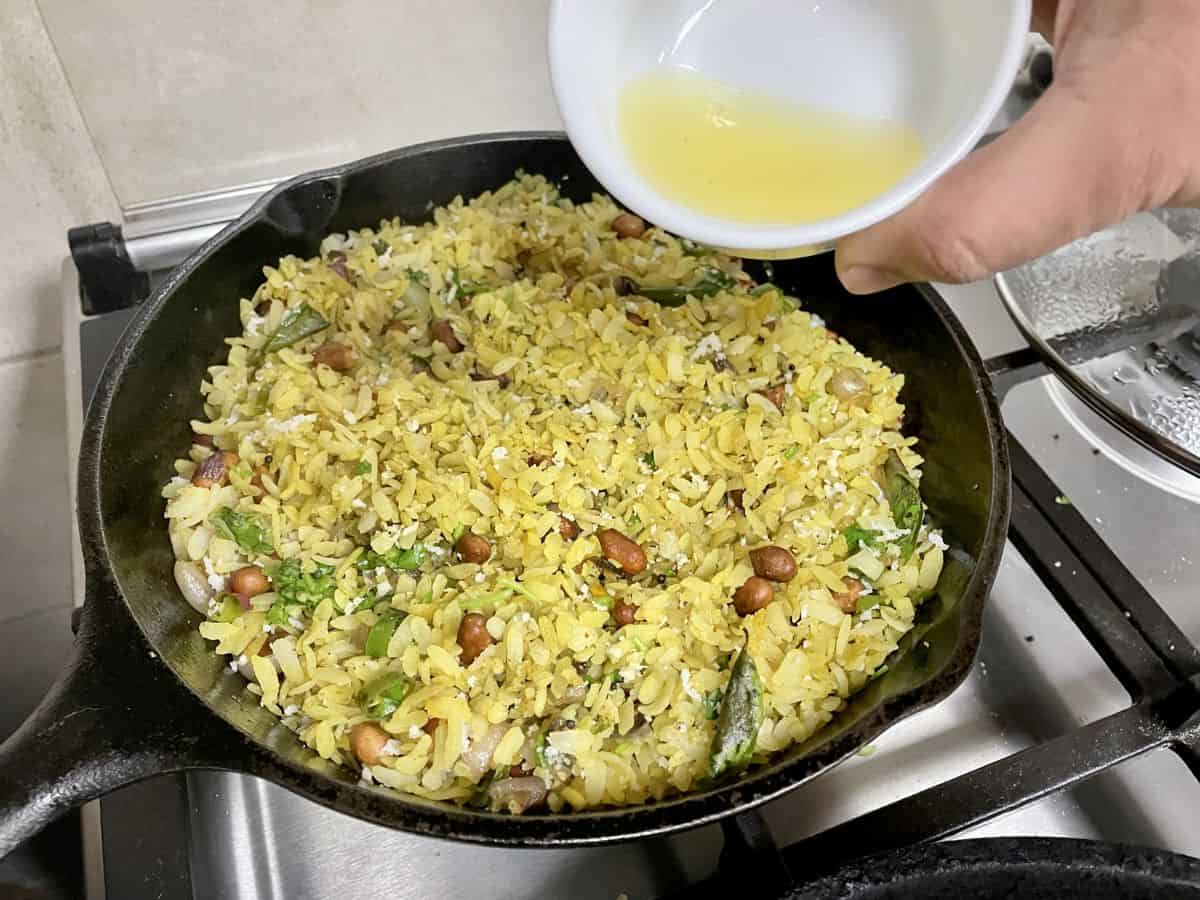
If you prefer a tangy taste, you can squeeze some lemon juice over the poha at this stage. I highly recommend doing this just before serving. If using cast iron like me, serve immediately after adding lime juice.
Serve the Kanda Poha hot, garnished with more coriander leaves and accompanied by lemon wedges on the side.
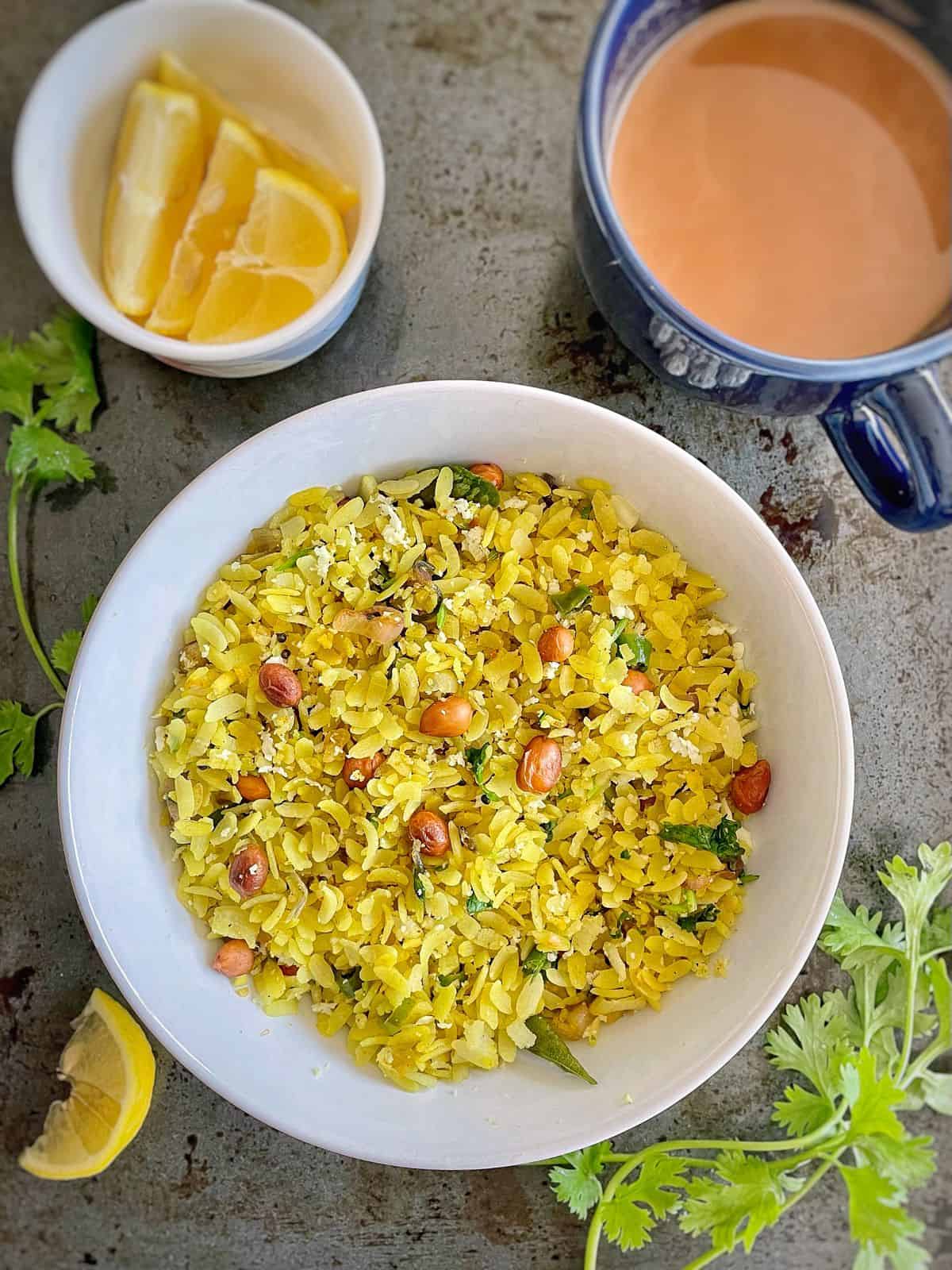
Hint: I found that organic thick poha tends to absorb more than thick poha. If using organic poha, don't skip the resting time after switching off. Keeping the skillet covered is crucial as this infuses flavour and softens the poha further.
Substitutions
The ingredients for the Kanda poha recipe are simple and you may already have them in your pantry. But I am going to list some of the obvious substitutions so you can still make this easy Indian breakfast.
- poha- In a pinch, you can replace poha with rolled-oats but may not be gluten-free.
- red onion- you can replace this with shallots or yellow onion.
- mustard seeds - though an indispensable item here, if you don't have it, you can try using cumin seeds instead.
Variations
Poha is a gluten-free vegan dish by itself but feels free to whip up your heart's desire as the variations are endless. I am listing the three popular ones for inspiration.
- Kanda Batata Poha: This variation includes potatoes (batata) along with flattened rice. Use the same recipe but stir in boiled or fried potatoes chunks and season accordingly.
- Indori Poha: A popular street food from the city of Indore in Madhya Pradesh, India. This version typically includes ingredients like fennel seeds, cumin seeds, turmeric, and pomegranate seeds. I have never made this but is something I always want to try.
- Vangi Poha: This variation includes eggplants (vangi) as one of the main ingredients. The eggplants are diced and pan-fried before adding to the poha.
If you happen to have puffed rice instead of flattened rice flakes, then try my spicy murmura recipe. You can also make something similar using chickpea.
Equipment
To make any poha, you don't require any specialized equipment. The basic kitchen tools and utensils needed are:
- A colander or strainer to rinse the poha with water and drain excess water immediately.
- A skillet or kadhai to saute and cook.
- A spoon or spatula for mixing and stirring the ingredients while cooking.
- a fitting lid to keep the pan covered.
Storage
It's worth noting that poha is typically a quick-cooking dish and is often prepared fresh when needed. However, if you have leftover poha or want to prepare it in advance for convenience, following these storage guidelines can help maintain its quality for a short period.
- Transfer the cooled poha to an airtight container to maintain its freshness.
- Place the container in a cool, dry area of your kitchen or pantry for same day serving.
- Poha is best consumed within a couple of days of preparation for optimal taste and texture. After that, it may start to lose its freshness and become stale.
- You may store leftover poha in the fridge in an closed container.
Top tip
To reheat refrigerated poha, bring it to room temperature and warm it up in a covered skillet on low heat. A few splashes of water will help rehydrate the poha to freshness. You can also use the microwave and reheat for 30 seconds increments, stirring every time until warmed completely.
FAQ
The primary reason for poha becoming soggy is over-soaking. If poha is soaked in water for too long, it can absorb excess moisture, causing it to become mushy and lose its texture. Don't cover and cook if you accidentally over-soaked or rinsed because the steam or condensation from the covered lid can make the flakes damp and lead to sogginess. Lastly, the culprit for soggy poha is moist ingredients. Adding moist ingredients like tomatoes or sauces can make it soggy.
In my experience, dry poha is the outcome of under-soaking or not soaking in enough water to ensure every grain is just wet. Poha needs enough moisture to cook perfectly that is not too try and chewy nor too soft and soggy. You can always fix a dry poha by adding back splashes of water to keep them covered to steam. The same cannot be done if you start with an over-soaked poha.
It is best to use thick poha to make any poha dish. Thin poha absorbs moisture quickly and cooks faster resulting in mushy or soggy poha.
Related
Looking for recipes using flattened rice flakes? Try these:
Pairing
These are my favourite sides to serve with the Kanda Poha recipe:
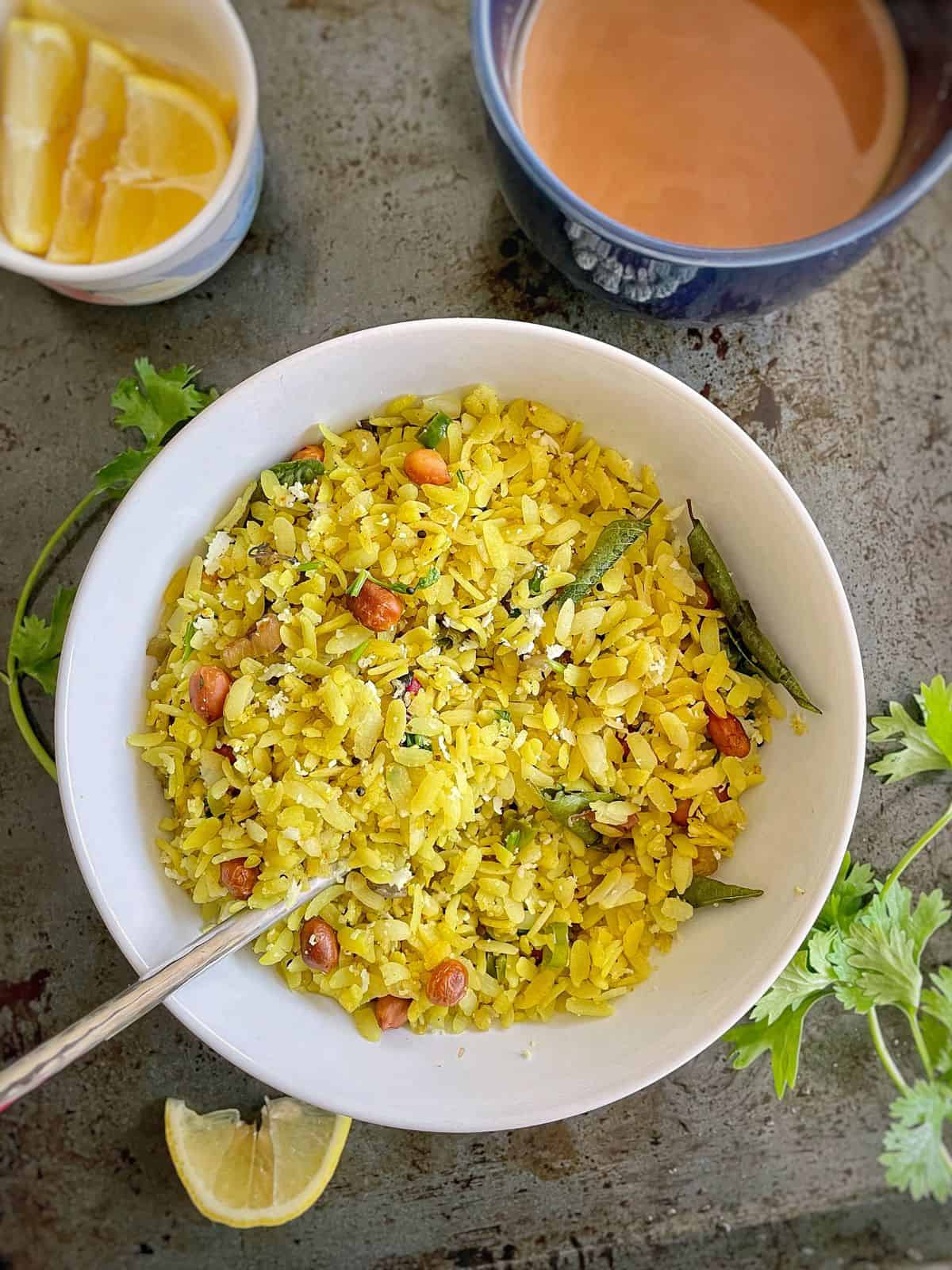
📖 Recipe Card
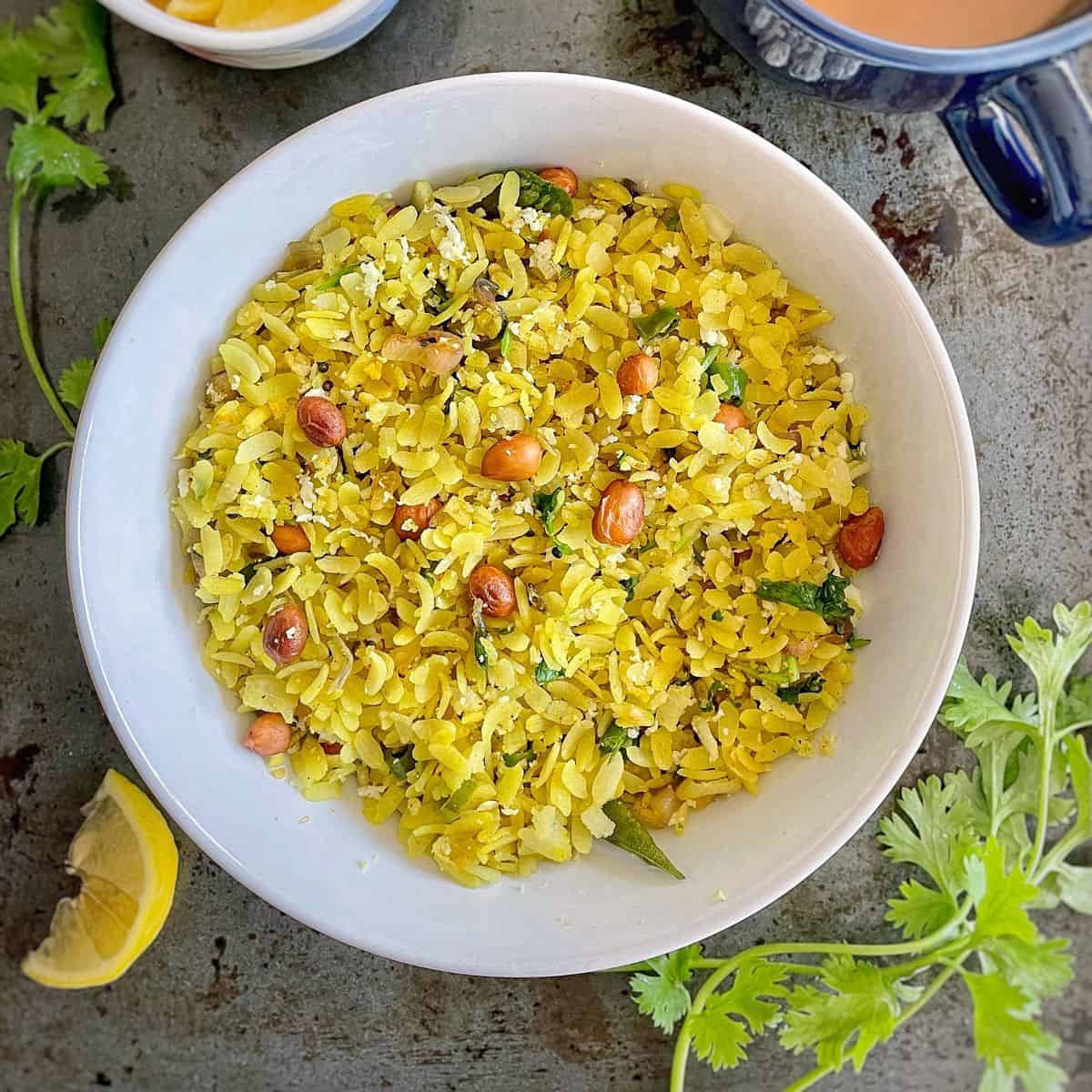
Kanda Poha Recipe
Ingredients
- 2 cups thick poha
- 2 cups water
- 2 tablespoon coconut oil
- 4 tablespoon peanuts, (see notes)
- 1 teaspoon mustard seeds
- 1 sprig curry leaves
- 1 medium onion
- 2-3 green chillies
- ½ teaspoon turmeric powder
- salt to taste
- Juice of half a lime
- 2 tablespoon chopped coriander leaves
- 4 tablespoon grated coconut
Instructions
Prepare the Poha:
- Place the measured-out poha (rice flakes) in a colander with a bowl underneath.2 cups thick poha
- Use a pourable container to measure the drinking water.2 cups water
- Pour the water carefully over the poha, ensuring the entire surface area is wet. Avoid stirring or flipping the poha to prevent sogginess or dryness.
- Set it aside for 15 to 20 minutes, optionally covered for safety.
Drain and Soften the Poha:
- Allow excess water to drain off during the soaking time. The poha will soften as it absorbs the water.
Prepare the Seasoning:
- Heat coconut oil in a pan or kadhai over low to medium heat.2 tablespoon coconut oil
- Add raw peanuts (with skin) and fry by sauteing until they pop and crack, being careful not to burn them.4 tablespoon peanuts
- Move the fried peanuts to one side of the pan and add mustard seeds. Wait for the mustard seeds to crackle.1 teaspoon mustard seeds
Flavor the Dish:
- Add curry leaves to the pan, whole, torn, or finely chopped.1 sprig curry leaves
- Introduce chopped green chillies and diced red onions. Saute briefly until their aroma is released.1 medium onion2-3 green chillies
- Cook the onions until they become translucent and slightly golden brown.
- Sprinkle turmeric powder and salt into the pan, ensuring even coating of the spices on the onions.½ teaspoon turmeric powdersalt to taste
Combine and Cook:
- Add the soaked and drained rice flakes (poha) to the pan.
- Gently mix everything, ensuring the poha is evenly coated with the onion and spice mixture. Mix until the mixture turns yellow.
- Cover the pan with a lid and cook on low heat for 2-3 minutes.
Final Touches:
- Turn off the heat and garnish with grated coconut and freshly chopped coriander leaves.2 tablespoon chopped coriander leaves4 tablespoon grated coconut
- For a tangy taste, squeeze some lemon juice over the poha just before serving (recommended). If using cast iron cookware, serve immediately after adding lime juice.Juice of half a lime
Serve and Enjoy:
- Serve the Kanda Poha hot, garnished with additional coriander leaves. Provide lemon wedges on the side for extra tanginess.

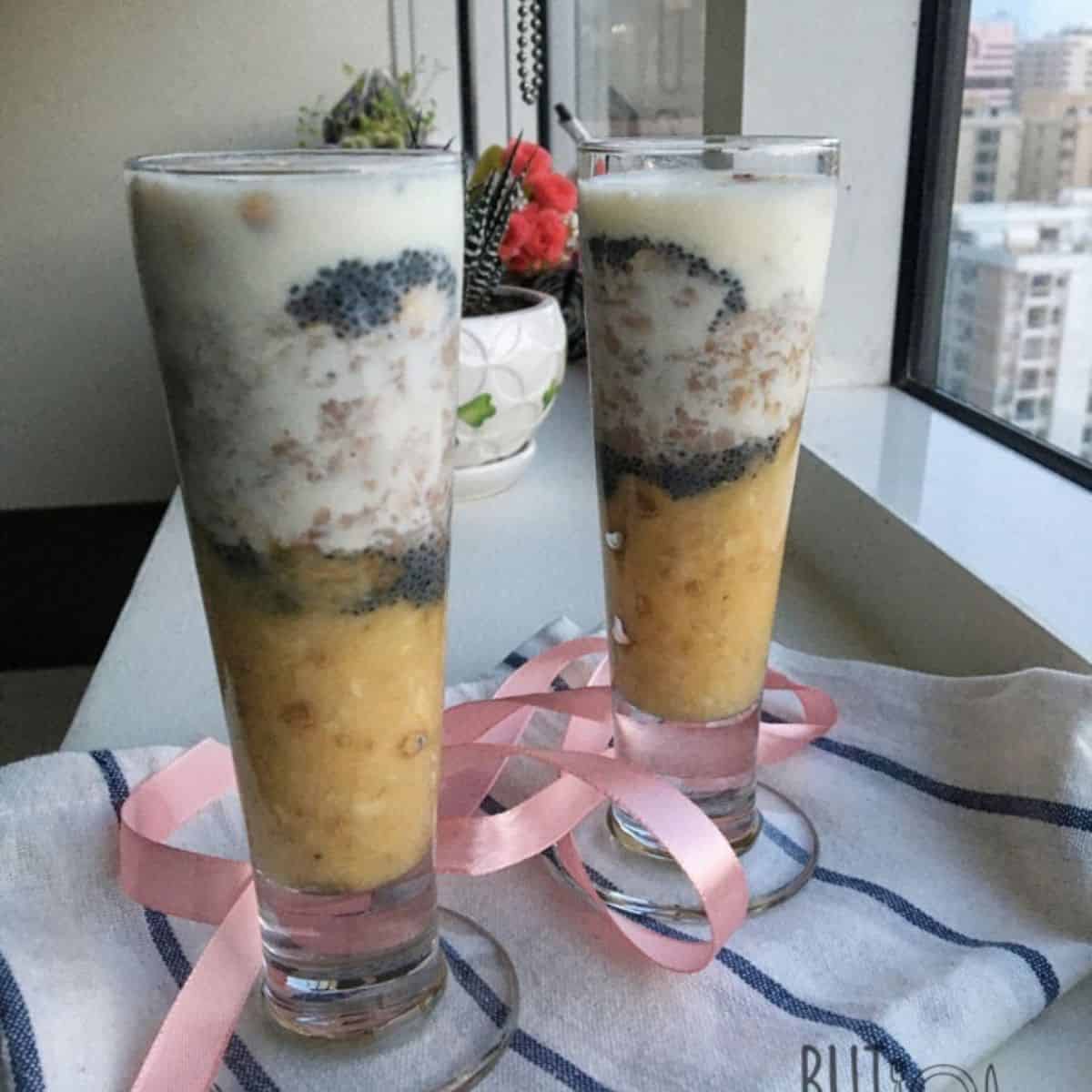


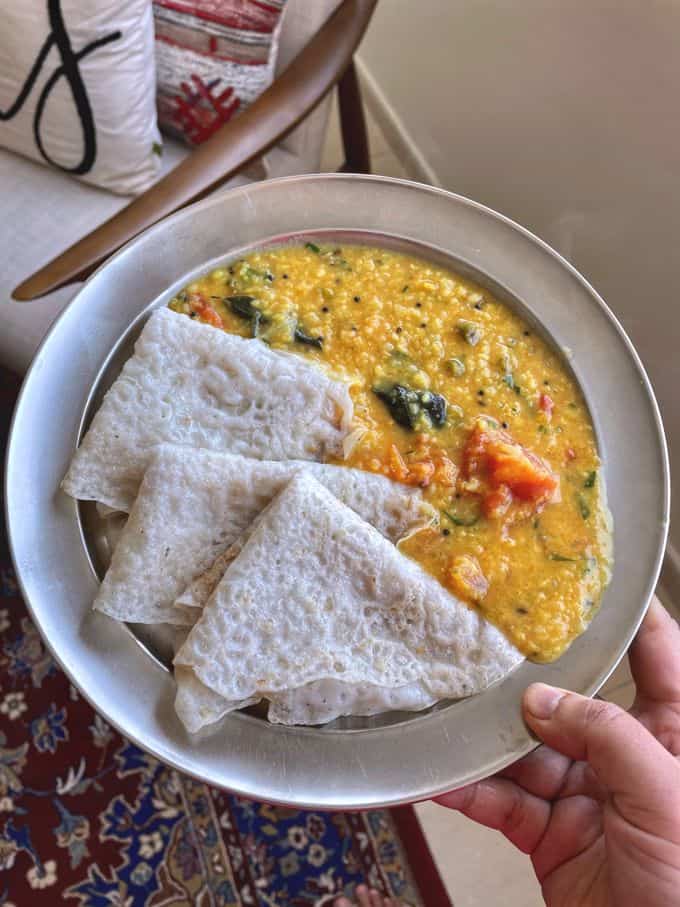



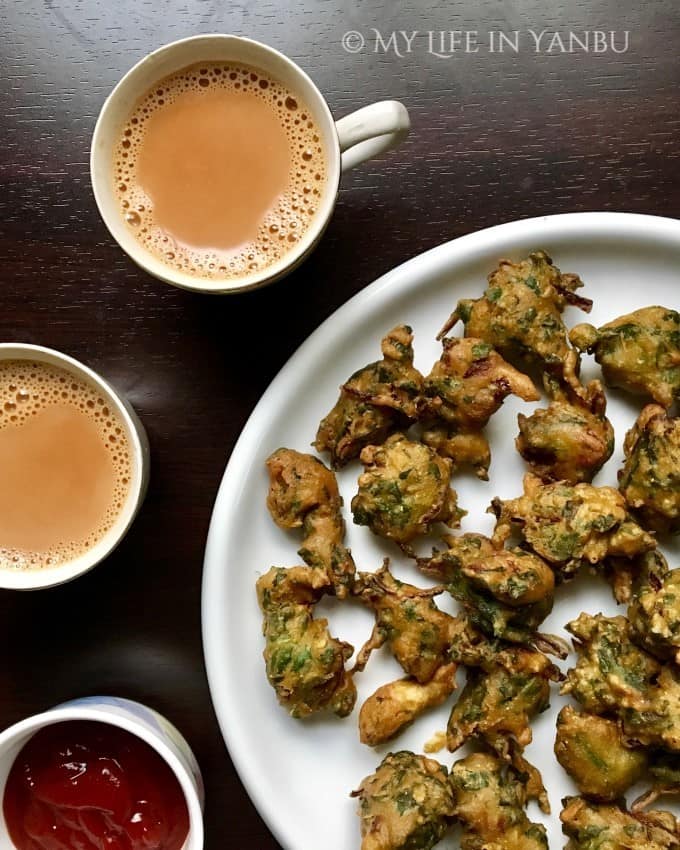

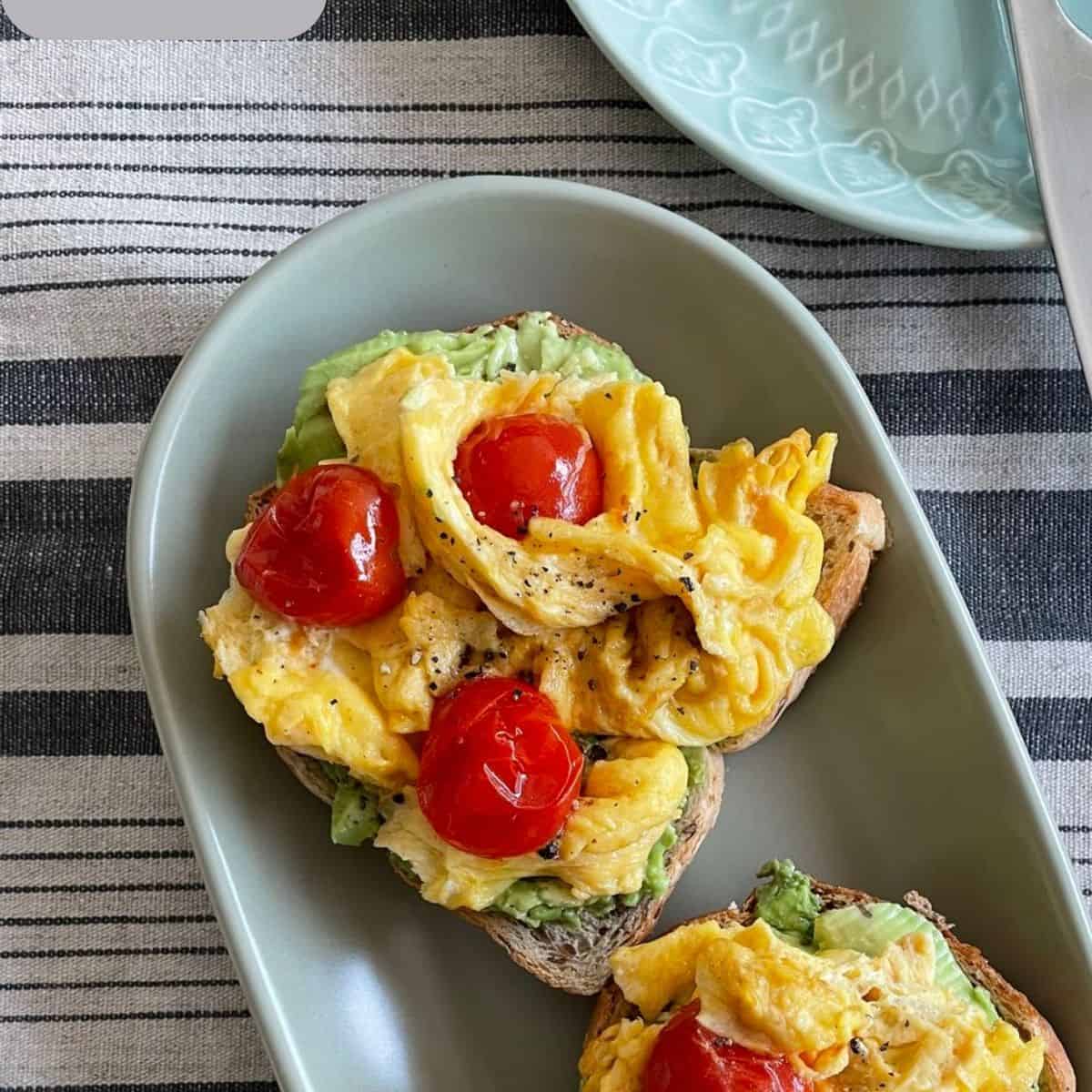


Famidha Ashraf says
We love this easy dish for breakfast or brunch but he always complains not enough peanuts! 😂 I hope you try and leave your feedback here!